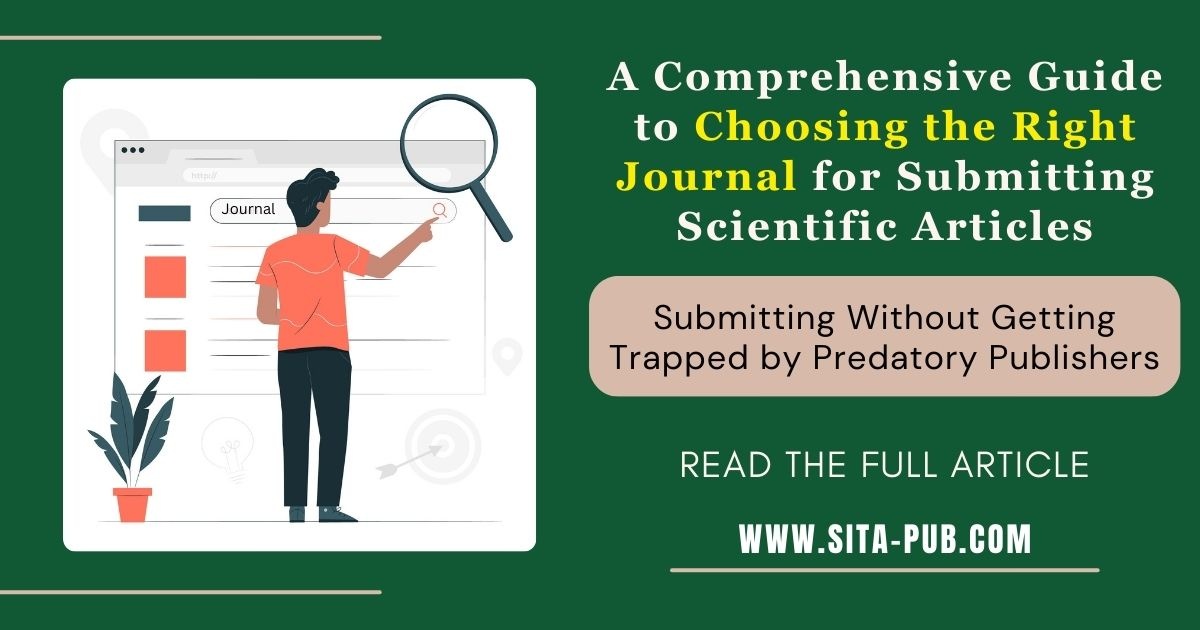A Comprehensive Guide to Choosing the Right Journal for Submitting Scientific Articles


Seeing your research in print is a defining moment in any scholar’s journey—but before you hit "submit," one big question stands in your way: Where should I publish?
With thousands of journals out there, picking the right one can feel overwhelming. Should you go for a high-impact journal? What about open access? How do you avoid getting trapped by predatory publishers?
Whether you're a seasoned academic or submitting your very first paper, this guide is here to make the journal selection process clearer, easier, and a lot less stressful.
Choosing the right journal isn’t just about prestige—it’s about getting your work seen by the right people, getting recognition, and building your academic profile.
The right journal can:
Speed up your publication process
Improve the reach and impact of your work
Help you earn academic credits and funding opportunities
Protect you from unethical publishers

Let’s walk through the types of journals you’ll come across, how to check their quality, and how to know when one is a good fit for your work.
Understanding the different types of academic journals is your first step. Each type serves a unique purpose and audience.
These are the gold standard in academic publishing. Peer-reviewed journals use experts in the field to evaluate your manuscript before it's accepted. This process ensures that only high-quality, original, and scientifically sound work gets published.
Indexed In:
Scopus (Elsevier)
Web of Science (Clarivate Analytics)
PubMed and MEDLINE (for medical/life sciences)
Embase (pharmaceutical sciences)
ERIC (education)
Some of Reputable Publishers:
Nature Publishing Group (Nature, Nature Communications)
Elsevier (The Lancet, ScienceDirect)
Springer Nature (Scientific Reports)
Wiley (Advanced Materials)
Taylor & Francis, SAGE, Oxford University Press, Cambridge University Press
Publishing in a peer-reviewed journal is often a requirement for academic promotion and grant applications, especially in competitive institutions.
These journals provide free, unrestricted access to their content online. The idea is simple: research should be accessible to everyone, not just those affiliated with institutions that can pay subscription fees.
Benefits:
Greater visibility and readership
Increased citation potential
Often quicker publication timelines
Well-Known Open Access Publishers:
PLOS (PLOS ONE, PLOS Medicine)
MDPI (Sustainability, Sensors)
BioMed Central (BMC Medicine, BMC Biology)
Frontiers (Frontiers in Psychology, Frontiers in Neuroscience)
Caution: Open access journals often charge an Article Processing Charge (APC), which can range from $500 to over $3,000. Always check this before submitting.
These are traditional journals where readers or libraries pay to access the articles. Authors typically do not pay a fee (unless they opt for open access publishing within the journal—known as the hybrid model).
Examples:
Cell (Elsevier)
JAMA (Journal of the American Medical Association)
IEEE Transactions
Nature Reviews Genetics
These journals are often highly selective and prestigious, making them competitive but rewarding for authors.
These focus on specific academic or professional fields. While they may not have a sky-high impact factor, they often offer:
A highly targeted readership
Faster review processes
Better fit for topic-specific research
Examples:
Journal of Environmental Psychology (Elsevier)
International Journal of Cultural Policy (Taylor & Francis)
Journal of Agricultural and Food Chemistry (ACS)
They’re typically indexed in Scopus, Web of Science, and subject-specific databases like PsycINFO, CINAHL, or AGRICOLA.
If your research spans more than one field (e.g., psychology + AI, medicine + ethics), interdisciplinary journals might be a great fit. They’re designed to showcase studies that don’t neatly fall into one academic silo.
Examples:
Nature Communications
Science Advances (AAAS)
Humanities and Social Sciences Communications (Springer)
These journals welcome complexity and often have high impact factors and broad audiences.
These journals cater to country- or region-specific research. They are particularly valuable when:
Your study focuses on local issues, populations, or policies
You want to build a national academic reputation
You aim to contribute to region-specific knowledge gaps
Examples:
Saudi Journal of Medicine & Medical Sciences
Chinese Journal of Mechanical Engineering
Indian Journal of Medical Research
These are journals that pretend to be legitimate but fail to offer real peer review or academic credibility. Their goal is profit, not quality. Publishing in one can harm your reputation and academic record.
Warning Signs:
Claims of "guaranteed acceptance" or "3-day peer review"
Poorly written websites
Fake impact factors or editorial boards
Not listed in Scopus, Web of Science, or DOAJ
Protect Yourself With:
Beall’s List (archived list of known predatory publishers)
Cabell’s Blacklist (subscription-based blacklist)
CrossRef or DOAJ checks
Always verify a journal’s indexing claims on the database’s official website—don’t take the journal’s word for it.
Indexing refers to whether a journal is included in a recognized database. If it’s indexed, it means your article is more likely to be seen, cited, and respected.
Scopus: Covers a broad range of disciplines; commonly used worldwide.
Web of Science (WoS): Focuses on high-impact, high-quality journals.
PubMed/MEDLINE: Key for biomedical and health research.
DOAJ: Trusted directory for quality open access journals.
ERIC: For education-related research.
Embase: Focused on pharmacology and clinical medicine.
Before submitting, check the journal’s indexing status. You can search directly on these platforms, or consult your university librarian for assistance.
Not all journals are created equal—even if they seem polished on the surface. Use this checklist to assess whether a journal is legitimate and reputable:
Is it indexed in a major database (e.g., Scopus, WoS, DOAJ)?
Does it clearly list its editorial board (with real academics)?
Are peer-review and ethical policies transparent and detailed?
Are APCs (if any) clearly explained?
Do you recognize the publisher's name or reputation?
Does the journal have recent publications and a stable publication history?

If you’re unsure, ask colleagues, mentors, or your university’s research office for input.

A journal that publishes thousands of papers might prioritize quantity over quality, risking lower prestige.
Conversely, a very selective journal may have a lower acceptance rate, requiring top-tier work.
Some journals take 3–12 months or longer from submission to publication.
Fast-track or open-access options can shorten this to 2–6 weeks, but may involve extra fees.
Check:
Average time for first decision
Time to final publication
Whether the journal offers online first publishing
As mentioned, indexing in WoS, Scopus, or other recognized databases is crucial for academic recognition.
Avoid journals not listed in these indexes unless required for a specific regional or niche purpose.
Review recent articles to:
Gauge the journal’s quality
Understand what types of research they accept
Identify trends in accepted methodologies or topics
Ensure your manuscript aligns with the journal’s disciplinary focus, thematic interest, and target audience.
Example:
A paper on AI in education may fit better in an interdisciplinary journal than a pure computer science one.
Open-access journals may charge Article Processing Charges (APCs) ranging from $500 to over $3000.
Some offer waivers for low-income countries or early-career researchers.
Always verify:
APC amount
What's included (e.g., formatting, color figures)
Refund policy (if rejected after peer review)
Measures average citations over 3 years.
Higher is better but should be interpreted within field norms.
Accounts for the quality of citations.
Reflects prestige more than quantity.
Adjusts for field-specific citation practices.
Useful for comparing journals across disciplines.
They reflect not just quantity of citations but also influence and visibility.
Used in university rankings, funding decisions, and promotion reviews.
Related Article
Most recognized metric in academic circles.
Higher IF often correlates with journal prestige.
Journals are ranked within categories.
Q1 journals are top 25% in their field and are highly prestigious.
Recognized by most academic institutions globally.
Often required for Graduation, faculty promotions, and government grants.
Related Article
Several tools help you generate a list of relevant journals based on your manuscript’s title, abstract, or keywords:
JANE (Journal/Author Name Estimator): Great for medical and biological sciences.
Elsevier Journal Finder: Suggests Elsevier journals matching your paper.
Springer Journal Suggester: Finds Springer journals suited for your work.
IEEE Publication Recommender: Ideal for engineering and computer science.
These tools are a starting point, not the final word—you still need to vet each journal carefully.
Step | Action | How to Do It | What to Look For | Eliminate If | Tips |
1. Revisit Your Manuscript Summary | Write a clear summary of your paper’s title, abstract, keywords, and main contributions. | Condense your research focus into 3-4 sentences. Use this as a benchmark to evaluate journal fit. | Clear, specific research scope. | Journals that don’t match your paper’s core topic or keywords. | Keep this summary handy to stay focused on relevance during screening. |
2. Check Journal Scope and Aims | Visit each journal’s website and read the “Aims and Scope” section carefully. | Compare your manuscript summary with the journal’s focus areas. | Journals whose stated scope covers your research area and methodology. | Journals with broad or unrelated scopes. | Some journals accept interdisciplinary work; note if yours qualifies. |
3. Verify Indexing and Credibility | Search for each journal in databases like Scopus, Web of Science, DOAJ, or PubMed. | Confirm the journal is indexed and check the editorial board credentials. | Journals indexed in major databases with credible editorial boards. | Journals not indexed or showing predatory journal traits (fake editorial board, unclear peer review). | Use tools like Cabell’s whitelist/blacklist or consult your librarian for verification. |
4. Compare Journal Metrics and Reputation | Check impact factor, CiteScore, SJR, and quartile rankings on official sites or SCImago. | Prioritize journals with metrics appropriate for your career stage and field. | Journals with reasonable impact and reputation; balance quality with acceptance chances. | Journals with no credible metrics or excessively low prestige if career progression depends on it. | Consider field norms: some fields have lower impact factor averages. |
5. Evaluate Timeline and Costs | Check average review and publication time from journal info or recent author reports. Review APCs or submission fees. | Journals with acceptable timelines and fees within your budget or funding support. | Journals with unreasonably long review times or fees you cannot afford. | Look for journals offering fee waivers if funding is limited. | |
6. Consider Your Personal Goals | Decide if you prioritize speed, visibility, niche audience, or prestige. | Match journals to your priority: fast publication for early career or niche focus for specialized impact. | Journals aligning with your goals and career plans. | Journals not matching your strategic objectives, even if prestigious. | Talk to mentors or peers about your goals to help clarify priorities. |
After applying the above criteria, list your top 2 or 3 journals.
Review their recent published articles to ensure style and quality match your expectations.
Prepare customized cover letters for each.
Submit to the highest priority journal first and be ready to submit to your backup options if rejected.
This structured approach helps you systematically eliminate ill-fitting journals and focus your effort on the best publishing opportunities, improving both the likelihood and quality of your publication.
Here are some insider tips from seasoned researchers to help you make smart journal choices:
Don’t underestimate specialized journals. Smaller audiences can mean your paper reaches exactly the right readers.
Ask your colleagues where they’ve published similar work. Their experience is invaluable.
Review how journals format and present articles. Clean, professional layouts often correlate with better readership and citations.
If you’re early career, consider regional journals. They may be more accessible and help you build a strong local reputation before aiming for global giants.
Avoid chasing impact factor alone. Relevance and audience fit matter more for your career and the impact of your work.
Look for journals with transparent peer-review policies. This shows commitment to quality and fairness.
Use multiple journal finder tools, but always cross-check recommendations.
Check if journals offer waivers or discounts on APCs. This can be a deciding factor if budget is limited.


Send Your Paper Abstract |

Receive Journal List |

Select Your Journal |

Start the Publication Process |
If you have any questions, inquiries, or would like to learn more about our services, please don't hesitate to reach out to us. Our dedicated team is ready to assist you.